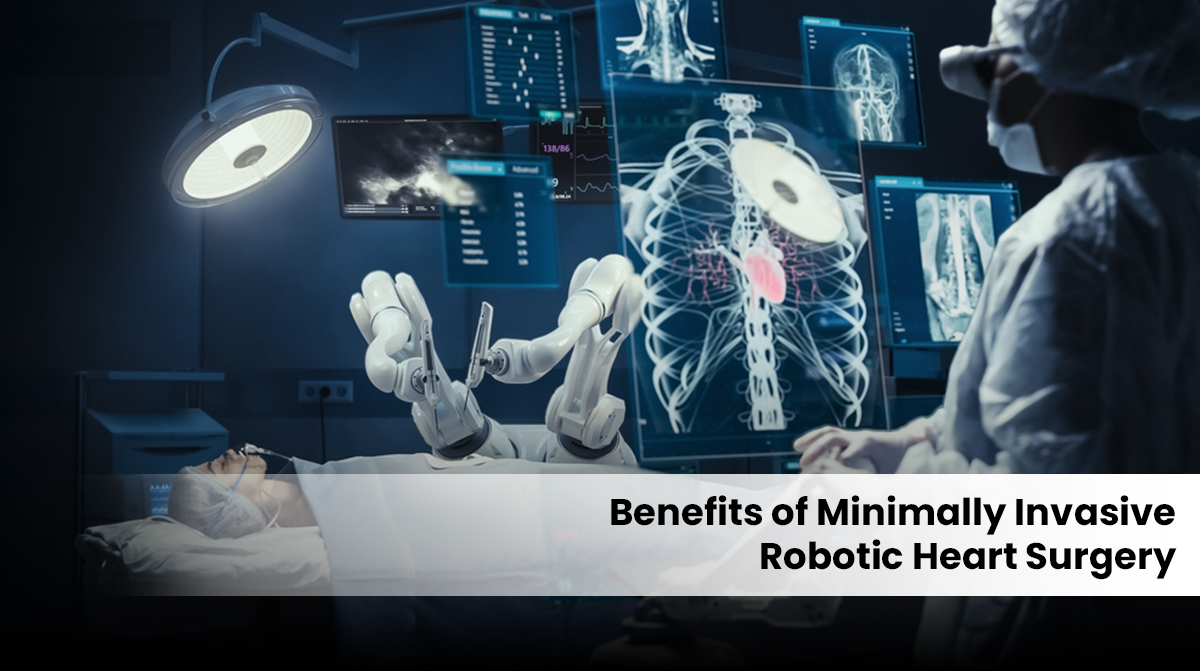
Heart surgery has evolved significantly over the past few decades. With advancements in medical technology, minimally invasive robotic heart surgery has become an increasingly popular choice for patients needing heart surgery. These innovations, such as robotic cardiac surgery, have dramatically improved the way surgeons operate, offering patients many advantages over traditional open-heart surgery. This article explores the Robotic cardiac surgery benefits and why minimally invasive techniques, particularly Minimally Invasive CABG Surgery, are gaining momentum in the field of cardiac care.
What is Minimally Invasive Robotic Heart Surgery?
Minimally invasive robotic heart surgery refers to procedures that use advanced robotic systems to assist surgeons in performing heart surgeries with small incisions. In these surgeries, robotic arms are used to carry out precise movements, guided by a surgeon using a console. This technique offers a highly accurate, effective, and efficient way to perform complex heart surgeries like Coronary Artery Bypass Grafting (CABG), valve repair, and other cardiovascular interventions.
Robotic systems like the da Vinci Surgical System allow surgeons to view a high-definition 3D image of the heart, which helps in making precise movements. This system mimics the surgeon’s hand movements, enhancing their control over the procedure, making it possible to perform operations through small incisions instead of the large chest opening required in traditional surgeries.
Key Benefits of Robotic Cardiac Surgery
Smaller Incisions and Reduced Scarring
One of the primary advantages of minimally invasive robotic heart surgery is the use of smaller incisions. Traditional open-heart surgery typically requires a large incision down the chest, which often results in significant scarring. In contrast, robotic cardiac surgery involves tiny incisions that are usually between 1 to 2 cm. These smaller incisions result in less visible scarring and a more aesthetically pleasing appearance post-surgery. The incisions are so small that they often don’t require stitches, and healing is faster.
Reduced Risk of Infection
Smaller incisions also significantly reduce the risk of infection. Because the cuts are much smaller, there’s less exposure to bacteria, and the body’s natural healing processes can close the wound more efficiently. With traditional surgery, the large incision presents a higher risk of infection, which can lead to longer hospital stays and complications.
Faster Recovery and Shorter Hospital Stays
Since robotic cardiac surgery is minimally invasive, recovery times are considerably faster compared to traditional surgery. Patients typically experience less pain, and the small incisions allow the body to heal more quickly. This means that patients are often able to leave the hospital in a matter of days, compared to the weeks it might take after traditional open-heart surgery.
Moreover, due to the reduced trauma to the body, patients can return to their daily routines and activities much sooner. Many people find that they can go back to work within a few weeks of surgery, instead of several months as with conventional heart surgery.
Less Pain and Discomfort
In traditional open-heart surgery, the recovery process is painful, as the sternum is cracked open to access the heart. This method requires significant pain management post-surgery, and the discomfort can last for a prolonged period. On the other hand, minimally invasive CABG surgery using robotic techniques allows patients to experience far less pain. The smaller incisions lead to fewer tissue disruptions, and the need for painkillers is often significantly reduced. Many patients report only mild discomfort, which is easily managed.
More Precision and Better Outcomes
The level of precision offered by robotic systems in robotic cardiac surgery is unmatched. The robotic arms are able to perform highly complex movements with greater accuracy than human hands, reducing the risk of errors and improving surgical outcomes. Surgeons can manipulate instruments with enhanced flexibility and precision, leading to a higher success rate for surgeries such as minimally invasive CABG surgery and valve repairs.
The robotic system also provides the surgeon with a high-definition, 3D view of the heart, which allows for better visualization of the area being treated. This increased visibility is crucial for ensuring that the procedure is carried out with the utmost precision.
Reduced Blood Loss
Due to the precise nature of robotic surgery, patients undergoing minimally invasive robotic heart surgery typically experience less blood loss compared to traditional procedures. The small incisions cause less disruption to the blood vessels, resulting in a lower need for blood transfusions during and after surgery. This reduces the likelihood of complications and accelerates the recovery process.
Lower Risk of Complications
With minimally invasive CABG surgery, there’s a reduced risk of complications such as blood clots, infections, and abnormal heart rhythms. The small incisions mean that the heart and surrounding tissues are exposed to less trauma, reducing the chances of inflammation or infection. Additionally, since the surgery is minimally invasive, the strain on the body is lessened, and the risk of complications like stroke or heart attack is minimized.
Better Cosmetic Results
Cosmetic outcomes are a significant concern for many patients, particularly those undergoing surgery at a relatively young age. Traditional open-heart surgery can leave patients with visible scars across their chest. In contrast, the small, discreet incisions used in robotic cardiac surgery often fade with time and are barely noticeable. This aesthetic benefit is especially important for individuals who are concerned about their appearance after undergoing a major procedure.
Precise Surgical Control with Enhanced 3D Visualization
With the use of robotic systems, surgeons can operate with more control and dexterity than ever before. The robotic arms are able to make finer, more controlled movements, which can be particularly beneficial in delicate surgeries, such as coronary artery bypass grafting or heart valve repair. Furthermore, the surgeon’s console offers a magnified, high-definition 3D view of the operating area, making it easier to detect any potential issues and address them swiftly.
Enhanced Surgeons’ Skills and Confidence
Surgeons using robotic systems often report higher levels of confidence, as the precision and ease of use offered by robotic technologies allow them to perform complex surgeries with greater certainty. This enhances not only the surgeon’s ability to carry out the procedure but also the overall patient experience. The collaboration between a skilled surgeon and advanced robotic tools results in better outcomes, making robotic cardiac surgery in Gurgaon and other locations a highly recommended option.
Robotic Cardiac Surgery in Gurgaon, A Step Toward a Healthier Future
The adoption of robotic cardiac surgery has made a tremendous impact on heart disease treatment worldwide. Patients in Gurgaon, a growing medical hub in India, can benefit from this cutting-edge technology, experiencing faster recovery, fewer complications, and better long-term outcomes. If you are considering heart surgery, it is important to choose a skilled surgeon with expertise in minimally invasive techniques.
Dr. Udgeath Dhir, a renowned expert in robotic cardiac surgery in Gurgaon, has helped countless patients regain their health through innovative, minimally invasive procedures. With years of experience and a focus on advanced techniques like minimally invasive CABG surgery, Dr. Dhir offers patients the best possible care in a state-of-the-art facility.
For those seeking robotic cardiac surgery in Gurgaon, Dr. Udgeath Dhir’s practice provides the perfect blend of technology, expertise, and patient-centered care. His commitment to using the latest advancements in surgery ensures that each patient receives the highest quality of treatment.
Conclusion
The Robotic cardiac surgery benefits are clear, from faster recovery times and reduced pain to improved surgical precision and better overall outcomes. As technology continues to advance, more patients are opting for these modern procedures, resulting in safer, more effective heart surgery. Whether you’re in Gurgaon or any other part of the world, robotic cardiac surgery is reshaping the landscape of heart disease treatment, offering patients a brighter, healthier future.
FAQs
Q1. What is robotic heart surgery?
A method where surgeons use robotic tools and small cuts instead of opening the chest to perform heart surgery.
2. What are its benefits?
Smaller scars, less pain, faster recovery, lower infection risk, and shorter hospital stay.
3. Who can have it?
Most patients needing surgery like CABG or valve repair may qualify; except some with poor heart/lung function or prior chest surgeries.
4. How long is recovery?
Hospital stay is around 3‑4 days; full return to normal in 2‑4 weeks.


